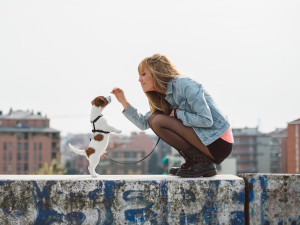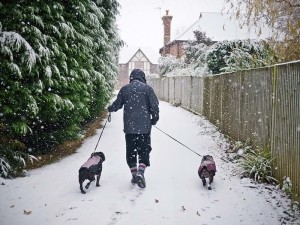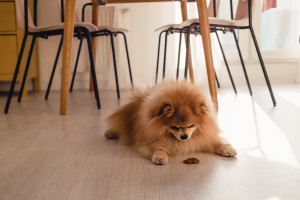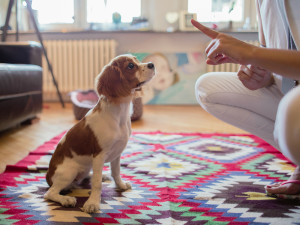Nine Useful Tricks to Teach Your Dog
Go beyond the basics.

Share Article
Many people consider dog tricks completely frivolous, or at least think that time spent training dogs to do them could be better invested in teaching useful skills. But if people realized the practical value of tricks, they might be willing to engage their dogs in learning a few.
There’s more to dog training than the basics like sit, lie down, heel, stay, and how to come on cue. Dogs who learn to “wait” can sit patiently at the house or car door until told to proceed, and it’s helpful when your dog learns to “leave it” when they spot food on the floor rather than scarf it up. If you’re ready to beef up your pup’s résumé and teach them a new skill, there are many tricks that offer more than just cute performance opportunities; here’s a list of useful dog tricks that go beyond the basics.
Nine tricks to teach your dog
Crawl.
Teaching your dog to crawl can be helpful as a way to clean themselves off. If you live with a dog who enjoys a good walk in the mud, ask your pup to crawl in some snow or grass to clean up a bit before heading inside.
Handshake.
When your dog has mastered the handshake, you can ask your dog to present a paw on cue when cutting their nails or at the vet to make a blood draw easier. It’s also useful for checking for pad injuries or just toweling off wet paws after a walk.

Wait.
The “wait” cue instructs your dog to pause and not to move forward until given permission to do so. It can literally be a lifesaver at doors to both houses and cars because it can prevent bolting out into traffic. Additionally, “wait” can be a sanity-saver when heading out for a walk because it stops the chaos that naturally results from overly-excited dogs who are so eager to go out for a walk that they act like they are out of their minds.
Belly up.
Teaching the “belly up” cue tells your dog to lie on their back with their legs in the air. If you have a dog that loves belly rubs, this is an easy one, but it can also help a vet perform an examination more easily.
Beg.
This cute trick provides another way for a dog to expose their belly, and comes in handy when you need to pull off burrs or seeds. If your dog’s balance is good, “beg” can also be a way to position a dog for a quick brush of the belly fur.
What?
This is a cue to your dog to tilt their head, which makes photos of dogs especially endearing no matter what position they’re in. The less time you spend trying to get dogs into specific poses, the more likely they are to have a friendly expression on their face.
Bow.
Having your dog perform a play bow on cue is more than just a cute trick; it can also help a dog who is a bit awkward or nervous around other dogs. The play bow is a social signal that means “What follows is playful in nature,” and performing one near other dogs can help social interactions start off on the right paw, easing tensions caused by confusing or unexpected behavior.
Up.
Up is a handy cue that tells your pup to jump or step onto something; it’s a great way to get big dogs to stand on the vet’s scale. It is even more helpful when combined with a solid stay, but that’s not always essential.
Dry off.
The “dry off” cue tells your dog to shake their whole body. This cue is helpful to have your dog shake off excess water before coming inside after a walk in the rain or a bath.
Being able to ask your dog to perform a behavior on cue makes many situations less anxiety-provoking. If your dog needs to perform a certain behavior, either for medical reasons or to further that fruitless, endless pursuit of cleanliness, it’s better to be able to communicate what we want than to physically manipulate them. Rather than grab them, lift them or push them around — however gently — it’s advantageous just to be able to tell your pup what you want and have them do it on their own through training. Tricks involve dogs putting their bodies (or at least parts of them!) in all sorts of positions, and that variety of movement and behavior is what gives dog tricks their practical value.

Karen B. London, PhD, CAAB, CPDT-KA
Karen B. London is a certified applied animal behaviorist (CAAB) and certified professional dog trainer (CPDT) who specializes in working with dogs with serious behavioral issues, including aggression. She has written for a variety of magazines including The Bark, Clean Run, and the APDT Chronicle of the Dog, and has published in scientific journals including Behavioral Ecology and Sociobiology, Ethology, Ecology, and Evolution, the Journal of Insect Behavior, and Insectes Sociaux. She is the author of seven books about dog training and canine behavior, including the forthcoming My Dog's Mystery Adventure: And Other Stories From a Canine Behaviorist and Dog Trainer.
Related articles
![Young blonde woman with a Jack Russell puppy during spring in the city.]()
The Best Training Treats for Dogs in 2025
The most mouth-watering treats for training your pup.
![Person with two small dogs that won't poop in snow]()
How to Teach Your Dog to Poop in the Snow
Snow days are fun—until your pup needs to do their thing outside.
![A Pomeranian dog sitting on the floor beneath a table looking at a treat awaiting permission to eat it]()
A Step-by-Step Dog Training Guide for “Leave It”
This simple dog training skill could save your dog’s life.
![Adorable puppy focused on learning commands at home in living room]()
Dog Training 101: What to Teach Your New Dog
In between cuddle sessions, work on these eight basic cues with your pup.




